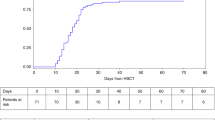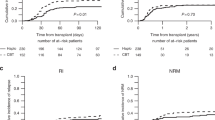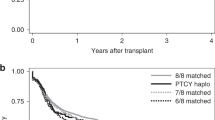Abstract
The treatment of Wiskott–Aldrich syndrome (WAS), a once uniformly fatal disorder, has evolved considerably as the use of hematopoietic stem cell transplant has become more widespread. For the majority of patients who lack an human leukocyte antigen-identical sibling, closely matched unrelated donor bone marrow transplant (MUD BMT) at an early age is an excellent option that nevertheless is not uniformly chosen. We retrospectively analyzed our experience with transplantation in 23 patients with WAS from 1990 to 2005 at the University of Brescia, Italy, of whom 16 received MUD BMT. Myeloablative chemotherapy was well tolerated with median neutrophil engraftment at day 18, and no cases of grade III or IV graft-vs-host disease. Overall survival was very good with 78.2% (18/23) of the whole cohort and 81.2% (13/16) of MUD BMT recipients surviving. Among 18 survivors, full donor engraftment was detected in 12 patients, and stable mixed chimerism in all blood lineages in four patients. Deaths were limited to patients who had received mismatched related BMT or who had severe clinical symptomatology at the time of transplantation, further emphasizing the safety and efficacy of MUD BMT when performed early in the clinical course of WAS.
This is a preview of subscription content, access via your institution
Access options
Subscribe to this journal
Receive 12 print issues and online access
$259.00 per year
only $21.58 per issue
Buy this article
- Purchase on Springer Link
- Instant access to full article PDF
Prices may be subject to local taxes which are calculated during checkout



Similar content being viewed by others
References
Parkman R, Rappeport J, Geha R, Belli J, Cassady R, Levey R et al. Complete correction of the Wiskott–Aldrich syndrome by allogeneic bone-marrow transplantation. N Engl J Med 1978; 298: 921–927.
Brochstein JA, Gillio AP, Ruggiero M, Kernan NA, Emanuel D, Laver J et al. Marrow transplantation from human leukocyte antigen-identical or haploidentical donors for correction of Wiskott–Aldrich syndrome. J Pediatr 1991; 119: 907–912.
Fischer A, Friedrich W, Fasth A, Blanche S, Le Deist F, Girault D et al. Reduction of graft failure by a monoclonal antibody (anti-LFA-1 CD11a) after HLA nonidentical bone marrow transplantation in children with immunodeficiencies, osteopetrosis, and Fanconi's anemia: a European Group for Immunodeficiency/European Group for Bone Marrow Transplantation report. Blood 1991; 77: 249–256.
Filipovich AH, Shapiro RS, Ramsay NK, Kim T, Blazar B, Kersey J et al. Unrelated donor bone marrow transplantation for correction of lethal congenital immunodeficiencies. Blood 1992; 80: 270–276.
Lenarsky C, Weinberg K, Kohn DB, Parkman R . Unrelated donor BMT for Wiskott–Aldrich syndrome. Bone Marrow Transplant 1993; 12: 145–147.
Ozsahin H, Le Deist F, Benkerrou M, Cavazzana-Calvo M, Gomez L, Griscelli C et al. Bone marrow transplantation in 26 patients with Wiskott–Aldrich syndrome from a single center. J Pediatr 1996; 129: 238–244.
Knutsen AP, Steffen M, Wassmer K, Wall DA . Umbilical cord blood transplantation in Wiskott Aldrich syndrome. J Pediatr 2003; 142: 519–523.
Filipovich AH, Stone JV, Tomany SC, Ireland M, Kollman C, Pelz CJ et al. Impact of donor type on outcome of bone marrow transplantation for Wiskott–Aldrich syndrome: collaborative study of the International Bone Marrow Transplant Registry and the National Marrow Donor Program. Blood 2001; 97: 1598–1603.
Conley ME, Saragoussi D, Notarangelo L, Etzioni A, Casanova JL . An international study examining therapeutic options used in treatment of Wiskott–Aldrich syndrome. Clin Immunol 2003; 109: 272–277.
Zhu Q, Zhang M, Blaese RM, Derry JM, Junker A, Francke U et al. The Wiskott–Aldrich syndrome and X-linked congenital thrombocytopenia are caused by mutations of the same gene. Blood 1995; 86: 3797–3804.
Glucksberg H, Storb R, Fefer A, Buckner CD, Neiman PE, Clift RA et al. Clinical manifestations of graft-versus-host disease in human recipients of marrow from HL-A-matched sibling donors. Transplantation 1974; 18: 295–304.
Jin Y, Mazza C, Christie JR, Giliani S, Fiorini M, Mella P et al. Mutations of the Wiskott–Aldrich Syndrome Protein (WASP): hotspots, effect on transcription, and translation and phenotype/genotype correlation. Blood 2004; 104: 4010–4019.
Pirovano S, Mazzolari E, Pasic S, Albertini A, Notarangelo LD, Imberti L . Impaired thymic output and restricted T-cell repertoire in two infants with immunodeficiency and early-onset generalized dermatitis. Immunol Lett 2003; 86: 93–97.
Mazzolari E, Moshous D, Forino C, De Martiis D, Offer C, Lanfranchi A et al. Hematopoietic stem cell transplantation in Omenn syndrome: a single center experience. Bone Marrow Transplant 2005; 36: 107–114.
Mullen CA, Anderson KD, Blaese RM . Splenectomy and/or bone marrow transplantation in the management of the Wiskott–Aldrich syndrome: long-term follow-up of 62 cases. Blood 1993; 82: 2961–2966.
Keever CA, Small TN, Flomenberg N, Heller G, Pekle K, Black P et al. Immune reconstitution following bone marrow transplantation: comparison of recipients of T-cell depleted marrow with recipients of conventional marrow grafts. Blood 1989; 73: 1340–1350.
Kook H, Goldman F, Padley D, Giller R, Rumelhart S, Holida M et al. Reconstruction of the immune system after unrelated or partially matched T-cell-depleted bone marrow transplantation in children: immunophenotypic analysis and factors affecting the speed of recovery. Blood 1996; 88: 1089–1097.
Yamaguchi K, Ariga T, Yamada M, Nelson DL, Kobayashi R, Kobayashi C et al. Mixed chimera status of 12 patients with Wiskott–Aldrich syndrome (WAS) after hematopoietic stem cell transplantation: evaluation by flow cytometric analysis of intracellular WAS protein expression. Blood 2002; 100: 1208–1214.
Konno A, Wada T, Schurman SH, Garabedian EK, Kirby M, Anderson SM et al. Differential contribution of Wiskott–Aldrich syndrome protein to selective advantage in T- and B-cell lineages. Blood 2004; 103: 676–678.
Klein C, Nguyen D, Liu CH, Mizoguchi A, Bhan AK, Miki H et al. Gene therapy for Wiskott–Aldrich syndrome: rescue of T-cell signaling and amelioration of colitis upon transplantation of retrovirally transduced hematopoietic stem cells in mice. Blood 2003; 101: 2159–2166.
Strom TS, Turner SJ, Andreansky S, Liu H, Doherty PC, Srivastava DK et al. Defects in T-cell-mediated immunity to influenza virus in murine Wiskott–Aldrich syndrome are corrected by oncoretroviral vector-mediated gene transfer into repopulating hematopoietic cells. Blood 2003; 102: 3108–3116.
Charrier S, Stockholm D, Seye K, Opolon P, Taveau M, Gross DA et al. A lentiviral vector encoding the human Wiskott–Aldrich syndrome protein corrects immune and cytoskeletal defects in WASP knockout mice. Gene Therapy 2005; 12: 597–606.
Martin F, Toscano MG, Blundell M, Frecha C, Srivastava GK, Santamaria M et al. Lentiviral vectors transcriptionally targeted to hematopoietic cells by WASP gene proximal promoter sequences. Gene Therapy 2005; 12: 715–723.
Dupre L, Marangoni F, Scaramuzza S, Trifari S, Hernandez RJ, Aiuti A et al. Efficacy of gene therapy for Wiskott–Aldrich syndrome using a WAS promoter/cDNA-containing lentiviral vector and nonlethal irradiation. Hum Gene Ther 2006; 17: 303–313.
Wada T, Jagadeesh GJ, Nelson DL, Candotti F . Retrovirus-mediated WASP gene transfer corrects Wiskott–Aldrich syndrome T-cell dysfunction. Hum Gene Ther 2002; 13: 1039–1046.
Strom TS, Gabbard W, Kelly PF, Cunningham JM, Nienhuis AW . Functional correction of T cells derived from patients with the Wiskott–Aldrich syndrome (WAS) by transduction with an oncoretroviral vector encoding the WAS protein. Gene Therapy 2003; 10: 803–809.
Dupre L, Trifari S, Follenzi A, Marangoni F, Lain de Lera T, Bernad A et al. Lentiviral vector-mediated gene transfer in T cells from Wiskott–Aldrich syndrome patients leads to functional correction. Mol Ther 2004; 10: 903–915.
Snapper SB, Rosen FS, Mizoguchi E, Cohen P, Khan W, Liu CH et al. Wiskott–Aldrich syndrome protein-deficient mice reveal a role for WASP in T but not B cell activation. Immunity 1998; 9: 81–91.
Wengler GS, Notarangelo LD, Berardelli S, Pollonni G, Mella P, Fasth A et al. High prevalence of nonsense, frame shift, and splice-site mutations in 16 patients with full-blown Wiskott–Aldrich syndrome. Blood 1995; 86: 3648–3654.
Facchetti F, Blanzuoli L, Vermi W, Notarangelo LD, Giliani S, Fiorini M et al. Defective actin polymerization in EBV-transformed B-cell lines from patients with the Wiskott–Aldrich syndrome. J Pathol 1998; 185: 99–107.
Acknowledgements
This work was partially contributed by Ministero dell’Istruzione, dell’Università e della Ricerca (MIUR-PRIN 2004), and by the European Union (EURO-POLICY-PID Grant, SP23-CT-2005-006411).
Author information
Authors and Affiliations
Corresponding author
Rights and permissions
About this article
Cite this article
Pai, SY., DeMartiis, D., Forino, C. et al. Stem cell transplantation for the Wiskott–Aldrich syndrome: a single-center experience confirms efficacy of matched unrelated donor transplantation. Bone Marrow Transplant 38, 671–679 (2006). https://doi.org/10.1038/sj.bmt.1705512
Received:
Revised:
Accepted:
Published:
Issue Date:
DOI: https://doi.org/10.1038/sj.bmt.1705512
Keywords
This article is cited by
-
Un-manipulated haploidentical transplant in Wiskott-Aldrich syndrome
Indian Pediatrics (2017)
-
Recent Advances in Transplantation for Primary Immune Deficiency Diseases: A Comprehensive Review
Clinical Reviews in Allergy & Immunology (2014)
-
Dendritic cell functional improvement in a preclinical model of lentiviral-mediated gene therapy for Wiskott–Aldrich syndrome
Gene Therapy (2012)
-
Outcomes following hematopoietic cell transplantation for Wiskott–Aldrich syndrome
Bone Marrow Transplantation (2012)
-
Prolonged survival after splenectomy in Wiskott-Aldrich syndrome: a case report
Italian Journal of Pediatrics (2011)



